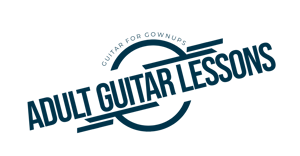In the early days of learning how to play guitar, one of the most frustrating things for a new guitar player to master is developing the skill to play chords that sound clear.
The problem is usually caused when fingers inadvertently mute adjacent strings resulting in the student playing a chord that sounds muffled.
Let’s use the open E chord as an example. Here is the fingering:
——0——————————–
——0——————————–
——1——————————–
——2——————————–
——2——————————–
——0——————————–
The first thing to be aware of is that the ideal spot to place your finger when fretting the guitar is in the area of the fret directly behind the fret “wire”. This area is the “sweet spot” and will produce the best tone.
It’s easier to play notes in the “sweet spot” of the fret when playing single notes, scales and runs, but with many chords on the guitar, the fingering pattern of the chord makes it impossible for all fingers to be placed directly on the sweet spot at the same time.
The above example of an open E chord is one of those types of chords. The 1st finger (on the 1st fret of the 3rd string) and the 3rd finger (on the 2nd fret of the 4th string) can be placed easily on the sweet spot of the fret. But the 2nd finger (on the 2nd fret of the 5th string) will be “crowded out” and have to be placed slightly behind the plane of the 3rd finger.
However, by addressing several other factors of finger and hand placement, you will be able to play this, and most other chords, without experiencing the muting and buzzing that is so annoying. These factors include – finger curl, wrist angle and thumb leverage.
1. Finger Curl – The optimum finger placement when forming chords is for the finger tip to attack the string directly on top of it so that the finger is only touching the desired string. Beginning guitarists have a tendency to lay fingers over and approach chords at an angle that causes the sides of the finger to touch adjacent strings causing muting.
By adjusting the curl of the fingers so that only the finger tips touch the desired string you can avoid the problem.
2. Wrist Angle – Many times the best way to adjust finger curl is by making adjustments to the angle of the wrist.
Exercise – Practice doing this by attempting to form the chord without touching the back of the guitar neck with your hand or thumb.
You are not actually trying to play the chord in this exercise, you are only trying to determine where your optimal point of attack is (on the fret board) by rotating the fingers and adjusting the wrist so that your finger tips are in the proper placement.
3. Thumb Leverage – It’s important to realize that the thumb can be used to increase the amount of finger pressure on the fret board. This is accomplished by placing the ball of the thumb on the back of the guitar neck and using it as a “clamp” to gain the desired amount of finger pressure to form the chord.
Using the exercise above (in #2 “Wrist Angle”), once you have made the adjustments to the fingers and wrist so that only the finger tips touch the desired string at the desired fret, hold that position and bring the thumb to the back of the neck where it feels natural.
This will generally be somewhere in the middle of the back of the guitar neck. Now, apply pressure with the thumb to the back of the neck and you will feel how this increases the pressure of the finger tips on the fret board in a “clamping” action.
Another thing you can do is practice forming chords one note at a time starting with the lowest note and working up.
For example, using the E chord (above), place the 2nd finger on the 2nd fret of the 5th string, and play only the open 6th string and the 5th string until it sounds clear.
Then add the 2nd finger on the 2nd fret of the 4th string and only play the 6th, 5th and 4th strings until they sound clear. Then continue the same process with the 1st finger.
This is something you can do with most any open chord that you are having difficulty with.
Follow these steps and before long that frustrating string muting and buzzing will be a thing of the past. Most of all, remember that no one is born knowing how to play guitar. It’s a process we all go through and it takes time, patience and practice, so hang in there and things will eventually start to fall into place for you!



